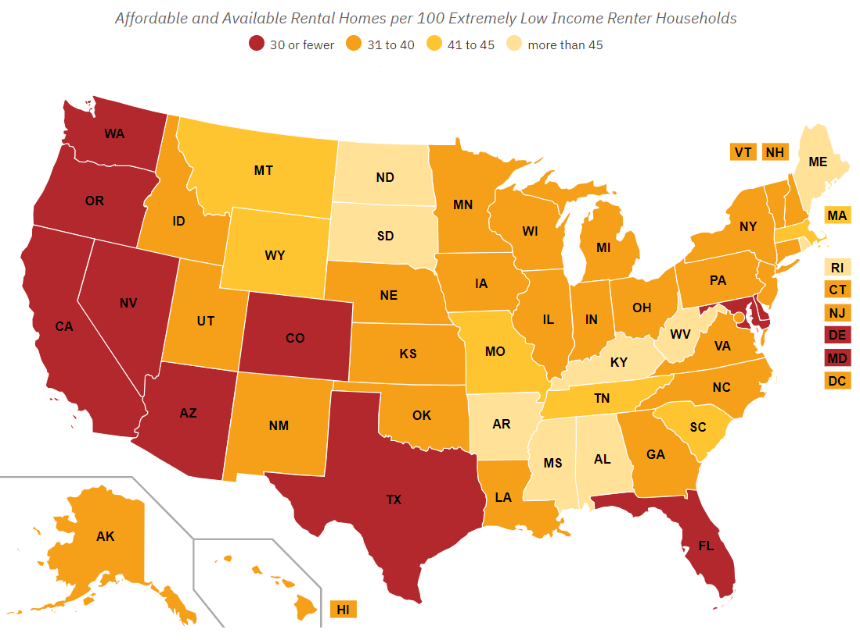
Spiking interest rates, rents, and the ever-increasing cost of living have been making headlines. Currently, the United States is experiencing a housing crisis – affordable housing is scarce, causing 2023 to be a record year for homelessness. Assistance is also increasingly difficult to come by; in one report, the New York Times highlighted that, despite years of progress in expanding services such as health coverage and food stamps, housing assistance for low-income households has fallen to its lowest levels in 25 years. Both renters and owners are facing an affordability crisis. The national median sale price for a single-family home has increased 25% and the average rent has risen 18% over the last five years.

Black, Indigenous, and people of color (BIPOC) communities are disproportionately affected by this housing affordability crisis, particularly following the COVID-19 pandemic, as residents of BIPOC communities are historically more likely than white households to be low-income earners and often face discrimination. The most recent National Low Income Housing Coalition Gap report revealed concerning data: the lowest-income renters in the United States face a shortage of 7.3 million affordable homes. To put this into perspective, for the 11 million extremely low-income renters in the United States, there are only 30 available homes for every 100 households. Investments in affordable housing have the potential to have near-term results with long-lasting impact. Investing in affordable housing is a comprehensive intervention that can help to alleviate the housing affordability crisis.
Read on to learn about ways that impact investments can increase access to housing and homeownership opportunities, reduce homelessness, and create pathways to social mobility.
Empowering Communities with Comprehensive Affordable Housing
One Community Development Finance Institution (CDFI) with national presence is dedicated to transforming lives and communities through innovative financial products and technical assistance. Their focus is on acquiring, developing, and preserving quality and resilient affordable housing for low- and moderate-income families.
This CDFI addresses systemic housing challenges by strategically investing in initiatives that preserve housing affordability for marginalized communities. Since its inception the organization has supported the creation and preservation of nearly one million homes and millions of square feet of community space.1 By helping families afford housing, the organization helps them stay local to good jobs, schools, transportation, and healthy living environments, contributing to the revitalization of communities.
Promoting Sustainable Living and Renovating Properties for Renters
Another fund is on a mission to enhance environmental practices through property acquisition and renovation. Rather than focusing on building new affordable units, this fund is maximizing positive impact by upgrading the quality of existing housing to improve the lives of low-income individuals.
This fund goes beyond typical real estate investments by prioritizing efficient water usage and renewable energy strategies while also offering credit. Additionally, the organization provides valuable support for residents through money management programs, education, and job training. In 2022, these environmental improvements and educational programming achieved significant results: millions of gallons of water saved, a significant decrease in electricity used by renters, and tens of thousands of participants took part in the social programs offered.4
Creating Long-Lasting Impact through Homeownership for BIPOC Communities
Another organization is dedicated to meeting the rising housing needs of underserved communities through affordable homeownership initiatives and financial tools, with a particular focus on advancing homeownership among marginalized groups. Notably, they launched an initiative emphasizing the importance of equitable home ownership opportunities and affordable housing solutions, for underserved Black communities in the United States. It currently actively supports thousands of households toward achieving affordable homeownership.5
Creating affordable housing opportunities means breaking intergenerational cycles of poverty and improving conditions for all. Comprehensive interventions like the examples above are providing housing support to low-income households so that they can be agents of change in their communities. Supporting initiatives such as these with investments has the potential to create near-term results of securing housing for those who need it and contribute to long-term positive changes like economic growth, health, education, and community development that will ultimately shape the lives of generations to come.
If you’re interested in learning more about how to support affordable housing initiatives with your investments, start a conversation with us. Housing is a social determinant of health (SDOH), one of the conditions in the environments where people live that affect health outcomes. To learn more about how housing and other SDOH can impact health disparities and improve health outcomes, check out our report on investing for health and equity, A Healthy Future.
3Reported to CapShift by organization.
4Reported to CapShift by organization.
5Reported to CapShift by organization.

